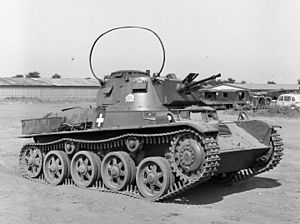38M Toldi
This article includes a list of general references, but it lacks sufficient corresponding inline citations. (November 2010) |
| 38M Toldi | |
|---|---|
 Command 38M Toldi I with antenna | |
| Type | Light tank |
| Place of origin | Kingdom of Hungary |
| Service history | |
| Used by | Kingdom of Hungary |
| Wars | World War II |
| Production history | |
| Produced | 1939–1942 |
| No. built | 202 |
| Variants | Toldi I, Toldi II, Toldi IIa, Toldi III |
| Specifications | |
| Mass | Toldi I: 8.5 t Toldi IIa: 9.3 t |
| Length | 4.75 m (15 ft 7 in) |
| Width | 2.14 m (7 ft 0 in) |
| Height | 1.87 m (6 ft 2 in) |
| Crew | 3 |
| Armour | Toldi I: 20 mm maximum Toldi II: 35 mm |
Main armament | 20 mm gun (Toldi I and Toldi II) 40 mm gun (Toldi IIa and Toldi III) |
Secondary armament | 1x 8 mm machine gun |
| Engine | Büssing-NAG V8 7.9 litres 155 bhp |
| Suspension | torsion bar |
Operational range | 200 km (120 mi) |
| Maximum speed | 47 km/h (29 mph) on road |
Steering system | clutch braking (all variants) |
The 38M Toldi was a Hungarian light tank, based on the Swedish Landsverk L-60 tank. It was named after the 14th century Hungarian knight Miklós Toldi.
Production history
The 38M Toldi was produced and developed under license from Swedish company AB Landsverk between 1939 and 1942. 202 were produced.
Variants
- Toldi I (k.hk. A20) - first variant armed with a 20 mm Solothurn anti-tank rifle,[1] 80 made.
- Toldi II (k.hk. B20) - variant with thicker front armour, 110 made.
- Toldi IIa (k.hk. B40) - modification developed in 1942, armed with 40 mm gun - 80 tanks of earlier variant were rearmed this way.
- Toldi III (k.hk. C40) - improved variant, only 12 made.
Combat history
Toldi tanks entered Hungarian service in 1940. They first saw action with the Hungarian Army against Yugoslavia in 1941.
These tanks were mostly used against the USSR between 1941 and 1944. Because of their light armour, armament and good communications equipment, they were mostly used for reconnaissance. The design was effective against Soviet light tanks widespread during the early stages of Operation Barbarossa, such as the obsolete T-26 and BT-5. However it was totally inadequate against the Soviet T-34 medium tanks encountered widespread during the later stages of the war on the Eastern Front.
Survivors
Two known surviving 38M Toldi tanks (one Toldi I and one Toldi IIa) are preserved on display at the Kubinka Tank Museum.
References
- ^ Zaloga, Steven J. (2018). The Anti-Tank Rifle. Oxford, UK: Osprey Publishing. p. 22. ISBN 978-1-4728-1722-8.
{{cite book}}: CS1 maint: ref duplicates default (link)
